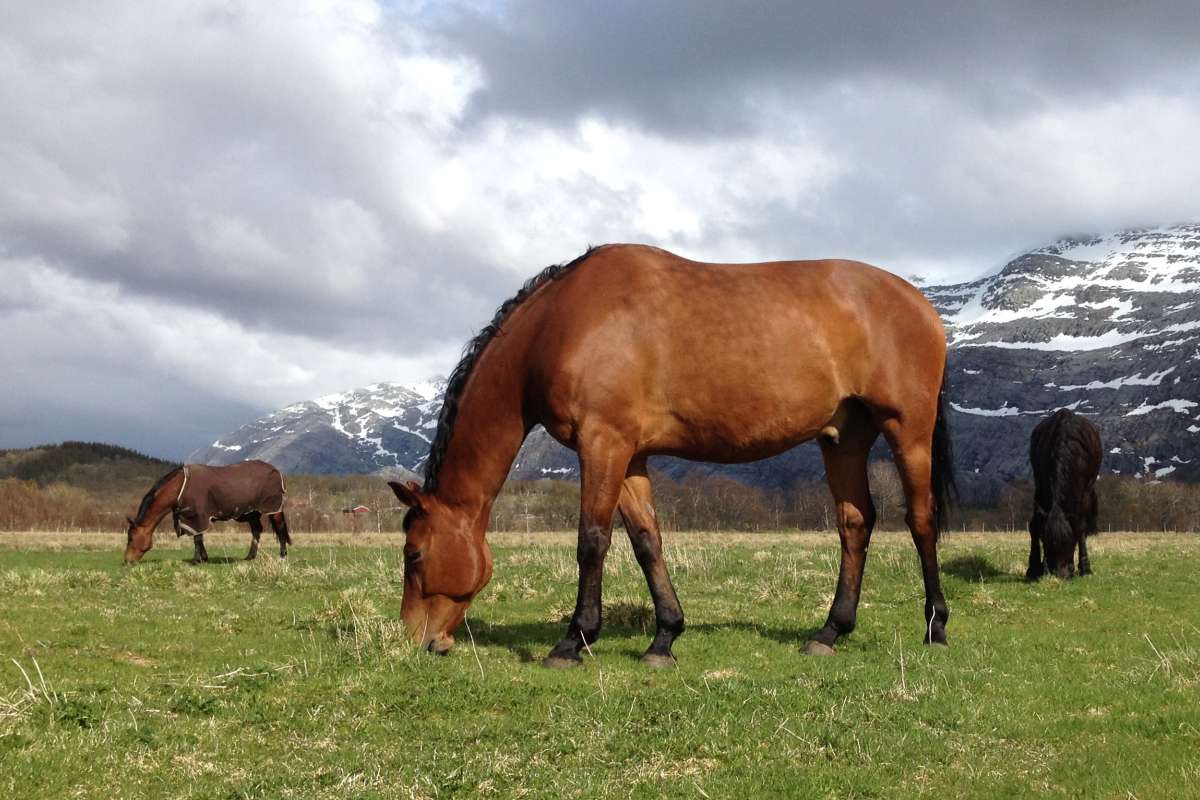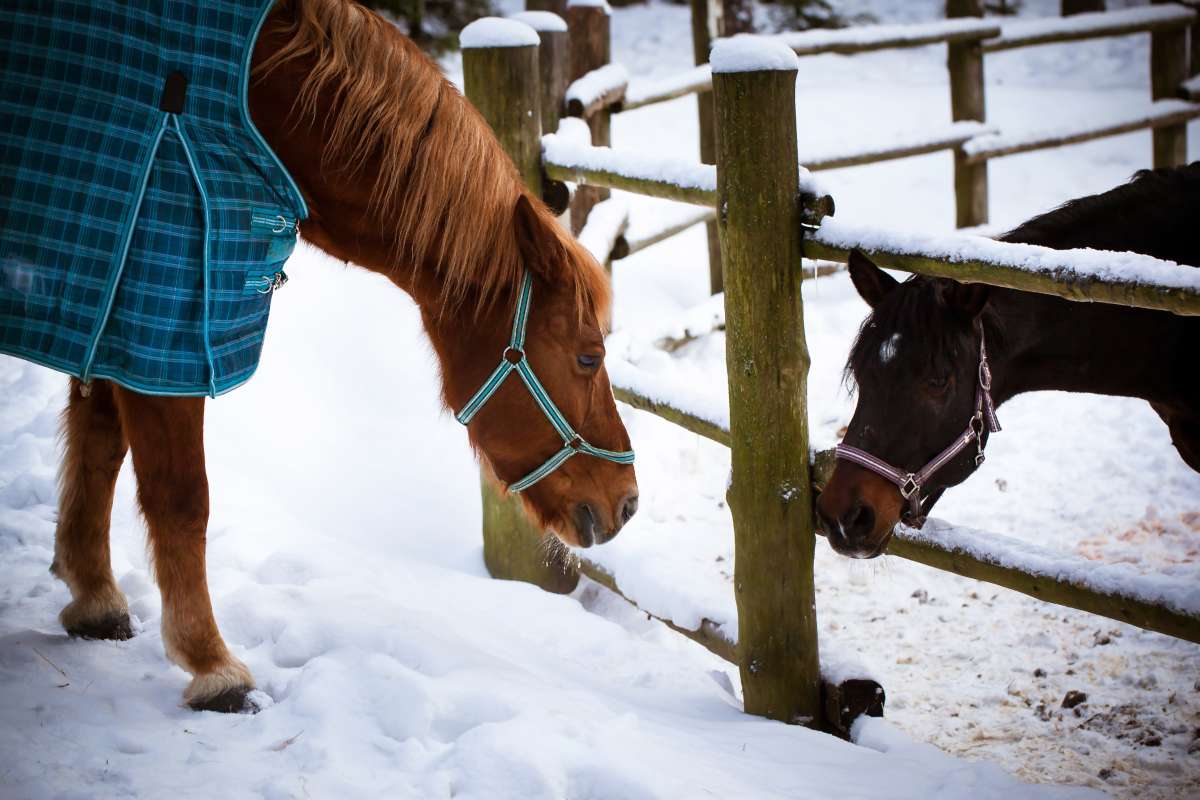Divisjon for matproduksjon og samfunn
Termoregulering hos hest
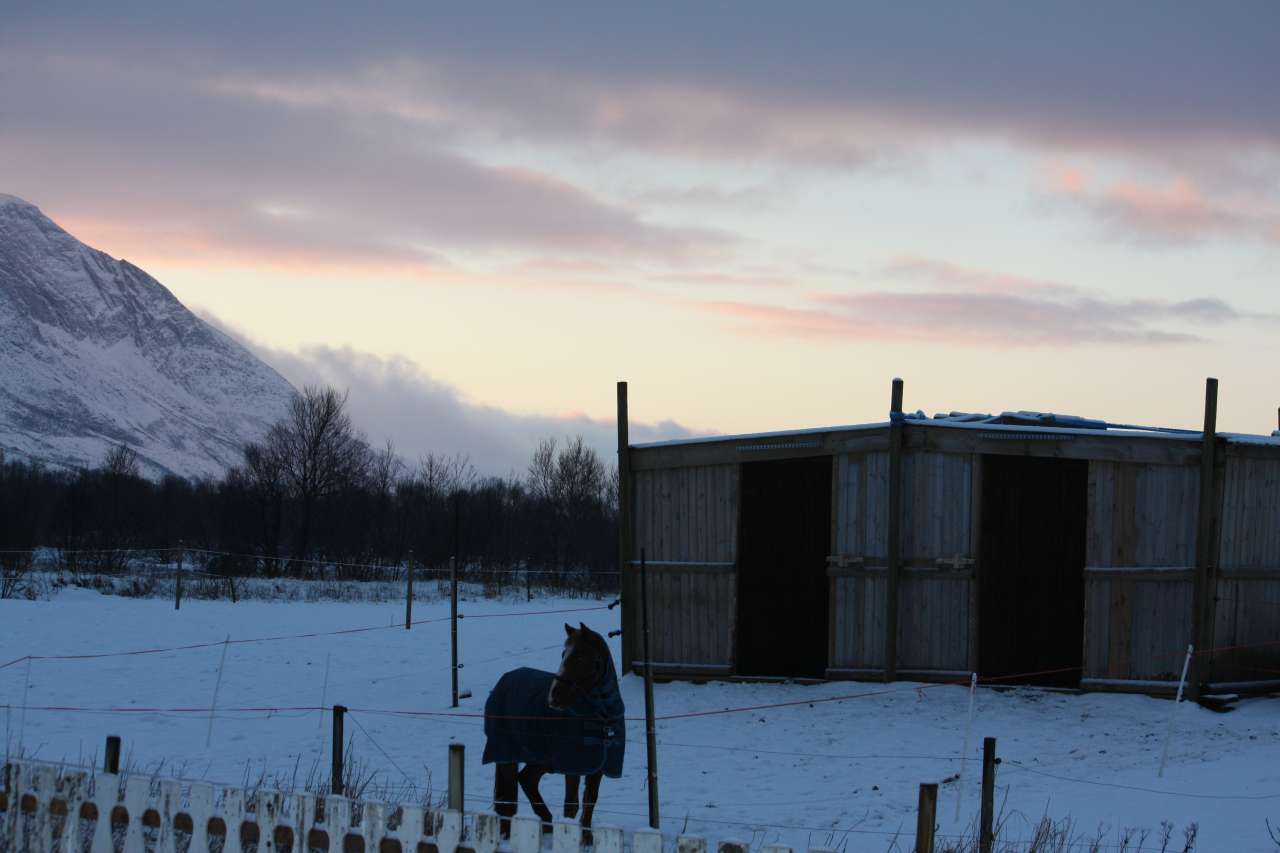
Slutt: juli 2015
Start: juni 2012
Perioder med ekstremvær, inkludert kulde og heteperioder, store nedbørsmengder og snø kan være en utfordring for hester som holdes utendørs i Skandinavia. Systemer med utegang kan i mange tilfeller være et godt alternativ til kostbare og energikrevende stallbygninger og enkelte stalleiere tilbyr nå kontinuerlig tilgang til luftegårder og gruppeoppstalling for å tilfredsstille hestens behov for fysisk aktivitet og sosial kontakt. Ulike hesteraser vil ha ulik forbrenning, forskjellig varmetap til sine omgivelser og svært forskjellig behov for kunstig beskyttelse. Dette finnes det imidlertid lite kunnskap om. Formålet med dette prosjektet var å studere hesters adferd og preferanser i kaldt vintervær for å kunne gi bedre anbefalinger til private hesteeiere som strever med å finne ut av dekkenbruk, pelslengde og oppstallingsmiljø som ivaretar hestens velferd i aktiv bruk.
Prosjektmedarbeidere
Knut Egil Bøe Cecilie Marie Mejdell Lise Aanensen Turid Buvik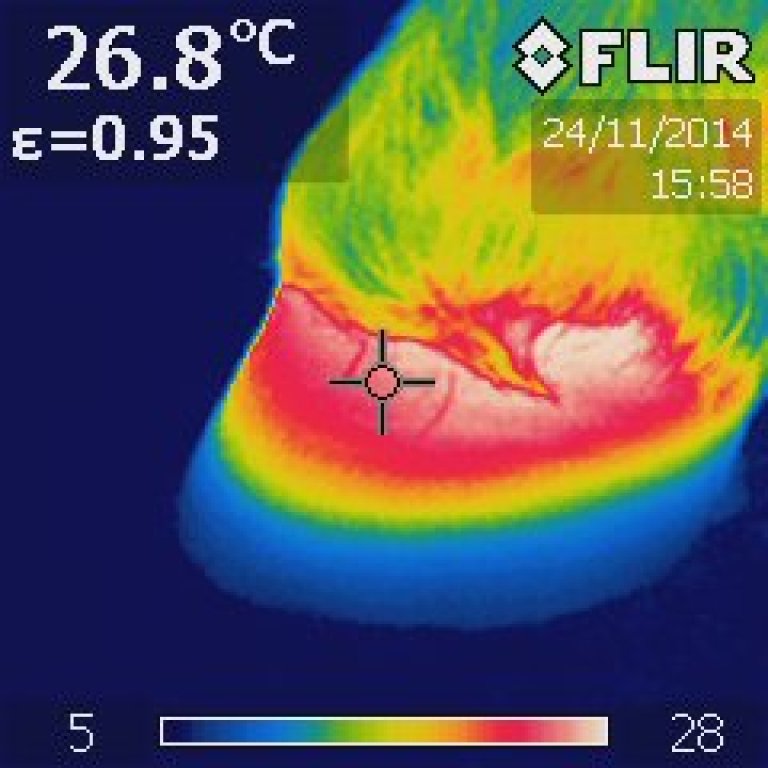
| Status | Avsluttet |
| Eksternt prosjektnettsted | http://www.bioforsk.no/ikbViewer/page/prosjekt/tema/artikkel?p_dimension_id=95504&p_menu_id=95514&p_sub_id=95505&p_document_id=92933&p_dim2=95509 |
| Start- og sluttdato | 01.06.2012 - 01.07.2015 |
| Prosjektansvarlig, NIBIO | Grete H. M. Jørgensen |
| Divisjon | Divisjon for matproduksjon og samfunn |
| Avdeling | Fôr og husdyr |
| Samarbeidspartnere | SLU, Veterinærinstituttet, NMBU og Trondheim Hundeskole |
| Totalt budsjett | 1569000 |
| Finansieringskilde | Stiftelsen Hästforskning |
Prosjektet var et samarbeid mellom SLU I Sverige, Veterinærinstituttet, NIBIO og NMBU. I Sverige undersøkte forskerne hestens preferanse for skygge om sommeren og de gjorde en større spørreundersøkelse på bruk av dekken. I Norge ble det gjennomført flere valgforsøk der hester av ulike raser fikk valget mellom å stå ute, gå inn i leskur med terassevarmer (strålingsvarme) eller gå inn i leskur uten strålingsvarme. Forsøket ble gjennomført på hester både med og uten dekken. Et annet forsøk målte pelslengde og infrarød temperatur fra overflaten av kroppen på hesten. Gjennom prosjektet ble det utviklet en metode for å lære hesten å kommunisere sine preferanser for dekken. Ved hjelp av symboler kunne hesten indikere "dekken av", "dekken på" eller "uforandret" da den ble spurt. I et oppfølgende forsøk spurte vi trente hester om deres preferanser for dekken under ulike vinterværforhold og resultatene tydet på at hesten ikke alltid var enig i eierens påkledningsanvisninger.
Det er produsert flere internasjonale vitenskapelige artikler og rapporter fra prosjektet. Ta kontakt med lokal prosjektansvarlig om du ønsker mer informasjon og ikke finner det selv.
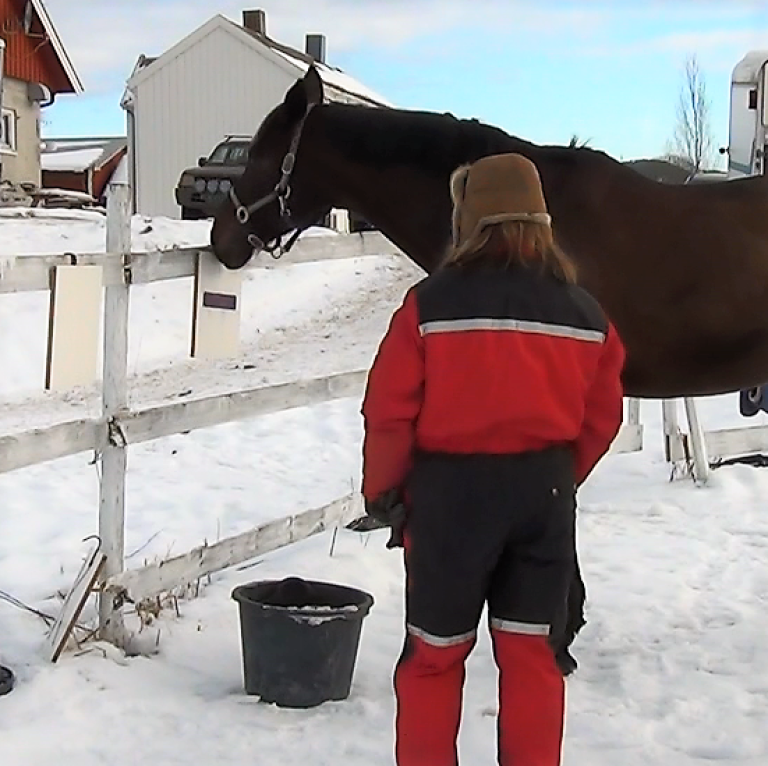
Publikasjoner i prosjektet
Sammendrag
Det er ikke registrert sammendrag
Sammendrag
Det er ikke registrert sammendrag
Forfattere
Knut Egil Bøe Grete Helen Meisfjord Jørgensen Turid Buvik Cecilie Marie MejdellSammendrag
Det er ikke registrert sammendrag
Forfattere
Cecilie Marie Mejdell Grete H. Meisfjord Jørgensen Knut Egil BøeSammendrag
Det er ikke registrert sammendrag
Sammendrag
Det er ikke registrert sammendrag
Forfattere
Knut Egil Bøe Grete Helen Meisfjord Jørgensen Cecilie Marie MejdellSammendrag
Det er ikke registrert sammendrag
Sammendrag
Det er ikke registrert sammendrag
Forfattere
Elke Hartmann Knut Egil Bøe Grete H. M. Jørgensen Cecilie Marie Mejdell Kristina DahlbornSammendrag
Limited information is available on the extent to which blankets are used on horses and the owners’ reasoning behind clipping the horse’s coat. Research on the effects of those practices on horse welfare is scarce but results indicate that blanketing and clipping may not be necessary from the horse’s perspective and can interfere with the horse’s thermoregulatory capacities. Therefore, this survey collected robust, quantitative data on the housing routines and management of horses with focus on blanketing and clipping practices as reported by members of the Swedish and Norwegian equestrian community. Horse owners were approached via an online survey, which was distributed to equestrian organizations and social media. Data from 4,122 Swedish and 2,075 Norwegian respondents were collected, of which 91 and 84% of respondents, respectively, reported using blankets on horses during turnout. Almost all respondents owning warmblood riding horses used blankets outdoors (97% in Sweden and 96% in Norway) whereas owners with Icelandic horses and coldblood riding horses used blankets significantly less (P < 0.05). Blankets were mainly used during rainy, cold, or windy weather conditions and in ambient temperatures of 10°C and below. The horse’s coat was clipped by 67% of respondents in Sweden and 35% of Norwegian respondents whereby owners with warmblood horses and horses primarily used for dressage and competition reported clipping the coat most frequently. In contrast to scientific results indicating that recovery time after exercise increases with blankets and that clipped horses have a greater heat loss capacity, only around 50% of respondents agreed to these statements. This indicates that evidence-based information on all aspects of blanketing and clipping has not yet been widely distributed in practice. More research is encouraged, specifically looking at the effect of blankets on sweaty horses being turned out after intense physical exercise and the effect of blankets on social interactions such as mutual grooming. Future efforts should be tailored to disseminate knowledge more efficiently, which can ultimately stimulate thoughtful decision-making by horse owners concerning the use of blankets and clipping the horse’s coat.
Forfattere
Cecilie Marie Mejdell Turid Buvik Grete H. Meisfjord Jørgensen Knut Egil BøeSammendrag
Det er ikke registrert sammendrag
Sammendrag
This paper describes a method in which horses learn to communicate by touching different neutral visual symbols, in order to tell the handler whether they want to have a blanket on or not. Horses were trained for 10–15 min per day, following a training program comprising ten steps in a strategic order. Reward based operant conditioning was used to teach horses to approach and touch a board, and to understand the meaning of three different symbols. Heat and cold challenges were performed to help learning and to check level of understanding. At certain stages, a learning criterion of correct responses for 8–14 successive trials had to be achieved before proceeding. After introducing the free choice situation, on average at training day 11, the horse could choose between a “no change” symbol and the symbol for either “blanket on” or “blanket off” depending on whether the horse already wore a blanket or not. A cut off point for performance or non-performance was set to day 14, and 23/23 horses successfully learned the task within this limit. Horses of warm-blood type needed fewer training days to reach criterion than cold-bloods (P < 0.05). Horses were then tested under differing weather conditions. Results show that choices made, i.e. the symbol touched, was not random but dependent on weather. Horses chose to stay without a blanket in nice weather, and they chose to have a blanket on when the weather was wet, windy and cold (χ2 = 36.67, P < 0.005). This indicates that horses both had an understanding of the consequence of their choice on own thermal comfort, and that they successfully had learned to communicate their preference by using the symbols. The method represents a novel tool for studying preferences in horses.
Sammendrag
Reasons for performing study: Horses may adapt to a wide range of temperatures and weather conditions. Owners often interfere with this natural thermoregulation ability by clipping and use of blankets. Objectives: To investigate the effects of different winter weather conditions on shelter seeking behaviour of horses and their preference for additional heat. Study design: Observational study in various environments. Methods: Mature horses (n=22) were given a free choice test between staying outdoors, going into a heated shelter compartment or into a nonheated shelter compartment. Horse location and behaviour was scored using instantaneous sampling every minute for one hour. Each horse was tested once per day and weather factors were continuously recorded by a local weather station. Results: The weather conditions influenced time spent outdoors, ranging from 52 % (of all observations) on days with mild temperatures, wind and rain to 88 % on days with less than 0°C and dry weather. Shivering was only observed during mild temperatures and rain/sleet. Small Warmblood horses were observed to select outdoors less (34 % of all observations) than small Coldblood horses (80 %). We found significant correlations between hair coat sample weight and number of observations outdoors (ρ = 0.23; P = 0.004). Conclusions: Horses selected shelters the most on days with precipitation and horses changed from a nonheated compartment to a heated compartment as weather changed from calm and dry to wet and windy. Horse breed category affected the use of shelter and body condition score and hair coat weight were associated with voluntary shelter selection.
Sammendrag
Det er ikke registrert sammendrag
Sammendrag
http://www.smp.se/baksidan/petronella-a-lindgren-hade-min-hast-valt-bort-mig/?share=eyJkYXRhIjp7InVybCI6Imh0dHA6XC9cL3d3dy5zbXAuc2VcL2Jha3NpZGFuXC9wZXRyb25lbGxhLWEtbGluZGdyZW4taGFkZS1taW4taGFzdC12YWx0LWJvcnQtbWlnXC8iLCJ0dGwiOiIxNDQzMDExODMwIiwidXNlcl9pZCI6IjU0ZGI1ZDAzOTk2ZTU5NzYyOTAwMDJjYiJ9LCJzaWduYXR1cmUiOiJyWGQ3XC9xQkU2cmduM3BEMk56SGM3RWpEbDBlZ3dreGFpcEtEYkZxT2ozUT0ifQ==
Sammendrag
Det er ikke registrert sammendrag
Sammendrag
Det er ikke registrert sammendrag
Forfattere
Knut Egil Bøe Grete Helen Meisfjord Jørgensen Cecilie Marie MejdellSammendrag
Det er ikke registrert sammendrag
Sammendrag
Det er ikke registrert sammendrag
Forfattere
Elke Hartmann Knut Egil Bøe Janne Winther Christensen Seppo Hyyppä H Jansson Grete H. M. Jørgensen Jan Ladewig Cecilie Marie Mejdell Yezica Norling Margareta Rundgren Susanne Särkijärvi Eva Søndergaard Linda J KeelingSammendrag
Keeping horses in groups is widely recommended but limited information is available about how this is implemented in practice. The aim of this survey was to describe how horses are kept in the Nordic countries in relation to sex, age, breed, and equestrian discipline and to assess owners’ attitudes toward keeping horses in groups. Horse owners in Denmark, Finland, Norway, and Sweden were approached using a web-based questionnaire, which was translated into 4 languages and distributed online via equestrian forums, organizations, and social media. The number of respondents was 3,229, taking care of 17,248 horses. Only 8% of horses were never kept in groups, 47% were permanently grouped for 24 h/d, and 45% were stabled singly but grouped during turnout. Yearlings were most often permanently kept in groups (75%), mares and geldings more commonly during parts of the day (50 and 51%, respectively), and stallions were often kept alone (38%). Icelandic horses were more likely to be permanently kept in groups (36%) than warmbloods (16%) and ponies (15%). Twice as many competition horses (51%) were never grouped compared with horses used for breeding (20%) or leisure purposes (15%). The majority of respondents (86%) strongly agreed that group housing benefits horse welfare and that it is important for horses to have the company of conspecifics (92%). Nevertheless, not all horses were kept in groups, showing that attitudes toward group housing may not necessarily reflect current management. The risk of injury was a concern of many respondents (45%), as was introducing unfamiliar horses into already established groups (40%) and challenges in relation to feeding in groups (44%). Safety of people (23%) and difficulties handling groupkept horses (19%) were regarded as less problematic. Results suggest that the majority of horses have the possibility to freely interact with other horses, either as fulltime members of a group during 24 h/d or during turnout. Future research should address the extent to which being a part-time member of a group affects horse welfare. For permanent group housing to become more widespread, such as it is the case for most farm animals, future research could focus on solving some of the reoccurring problems perceived with keeping horses in groups. The dissemination of evidence-based information on all aspects around keeping horses in groups can ultimately stimulate further positive changes in the management of group-kept horses.
Sammendrag
Det er ikke registrert sammendrag
Sammendrag
Det er ikke registrert sammendrag
Sammendrag
Det er ikke registrert sammendrag
Sammendrag
Det er ikke registrert sammendrag
Sammendrag
Det er ikke registrert sammendrag
Sammendrag
Det er ikke registrert sammendrag
Sammendrag
Det er ikke registrert sammendrag
Sammendrag
Det er ikke registrert sammendrag
Sammendrag
Det er ikke registrert sammendrag
Forfattere
Grete H. M. JørgensenSammendrag
Det er ikke registrert sammendrag
Sammendrag
Det er ikke registrert sammendrag
Sammendrag
Det er ikke registrert sammendrag
Forfattere
Elke Hartmann Grete H. M. Jørgensen Cecilie Marie Mejdell Knut Egil Bøe Kristina DahlbornSammendrag
Det er ikke registrert sammendrag
Forfattere
grete h m jørgensen Lise Aanensen Cecilie Marie Mejdell Knut Egil BøeSammendrag
Det er ikke registrert sammendrag
Forfattere
grete h m jørgensen Lise Aanensen Cecilie Marie Mejdell Knut Egil BøeSammendrag
The aim of this experiment was to investigate the effects of different winter weather conditions on shelter seeking behaviour of horses and their preference for additional heat. A total of 17 horses from different breeds were habituated to an experimental paddock with a double-room shelter. In one of the rooms a 1500 W infrared heater provided radiation heat, the other room was not heated. The horses were turned out in their regular paddocks for two hours and then moved to the experimental paddock, where they could stay either in the heated room, in the non-heated room or outside in the 10x6 m paddock. Using instantaneous sampling at one-minute intervals for one hour, a present observer recorded horse’s behaviour and location. A weather station recorded data on wind (directions and speed), precipitation, temperature and sunshine. We registered the horses’ breed, exercise level, body weight, height and body condition, and samples of the horses’ coats were taken for length and quality registration. A Kruskal Wallis test was performed on the preliminary data. We observed great individual differences in the horses’ preferred location under different weather conditions. Horses increased their activity during low temperatures, combined with wind and/or rain (P
Sammendrag
The aim of this experiment was to investigate the effects of different winter weather conditions on shelter seeking behaviour of horses and their preference for additional heat. A total of 17 horses from different breeds were habituated to an experimental paddock with a double-room shelter. In one of the rooms a 1500 W infrared heater provided radiation heat, the other room was not heated. The horses were turned out in their regular paddocks for two hours and then moved to the experimental paddock, where they could stay either in the heated room, in the non-heated room or outside in the 10x6 m paddock. Using instantaneous sampling at one-minute intervals for one hour, a present observer recorded horse’s behaviour and location. A weather station recorded data on wind (directions and speed), precipitation, temperature and sunshine. We registered the horses’ breed, exercise level, body weight, height and body condition, and samples of the horses’ coats were taken for length and quality registration. A Kruskal Wallis test was performed on the preliminary data. We observed great individual differences in the horses’ preferred location under different weather conditions. Horses increased their activity during low temperatures, combined with wind and/or rain (P<0.05). Ponies and warmblood horse breeds used the heated room to a greater extent than cold blood horse breeds (P<0.05). Horses with a low coat sample weight used the shelter more than horses with a large coat sample weight (P<0.05), and individuals with a large body condition score moved around more than individuals with a low body condition score (P<0.05). Muscle shivering was only observed during mild weather and rain. In conclusion, not only the horses breed but its body condition and coat characteristics also affect thermoregulation during winter weather. General activity also seemed to increase with wind, low temperatures and rain.
Sammendrag
Blanketing of horses is a very common management routine. Sometimes, this practice may seem unjustified. Therefore, we wanted to investigate the preferences of the horses themselves. First we developed a method by which the horse learned to communicate its wishes. Thirteen horses were trained to associate three different neutral visual symbols presented to them on a board with the actions 1) blanket is taken off, 2) blanket is put on, and 3) stay as is, and subsequently to communicate their wish by pointing at the relevant symbol. These horses had experience of wearing a blanket, but daily routines varied. All individuals which started the training programme succeeded in learning the task. Second, we tested the horse’ opinion under differing weather conditions. Horses normally wearing a blanket were tested with the blanket on, and those which normally did not, without. At the test days, the horse was taken out of its group and placed in a round pen. To be allowed to leave the round pen and join its pals again, the horse first had to make a choice among two symbols presented to them; to stay as is or to have the blanket removed/put on. The test was repeated under different climatic conditions (from -15 to + 20°C, sunny days and days with precipitation and wind) for each horse during winter, spring and autumn 2013. Preliminary results show that all horses made “sensible” choices. Nine out of the 13 horses wanted to remove the blanket for at least one test day. Naturally, cold blooded horses more often preferred to stay without, and shaved warm blooded horses more often preferred to stay blanketed. However, there were individual differences in both groups, showing that owner perception and the horse own opinion not always matched.
Forfattere
Cecilie Marie Mejdell Turid Buvik grete h m jørgensen Knut Egil BøeSammendrag
Det er ikke registrert sammendrag
Sammendrag
Det er ikke registrert sammendrag
Forfattere
grete h m jørgensen Lise Aanensen Cecilie Marie Mejdell Knut Egil BøeSammendrag
Det er ikke registrert sammendrag
Sammendrag
Det er ikke registrert sammendrag
Sammendrag
Det er ikke registrert sammendrag
Sammendrag
Det er ikke registrert sammendrag
Forfattere
Grete Helen Meisfjord Jørgensen Cecilie Marie Mejdell Knut Egil BøeSammendrag
Det er ikke registrert sammendrag
Forfattere
Cecilie Marie Mejdell Turid Buvik grete h m jørgensen Knut Egil BøeSammendrag
Det er ikke registrert sammendrag
Sammendrag
Det er ikke registrert sammendrag
Forfattere
Cecilie Marie Mejdell Turid Buvik grete h m jørgensen Knut Egil BøeSammendrag
Det er ikke registrert sammendrag
Sammendrag
Det er ikke registrert sammendrag
Sammendrag
Det er ikke registrert sammendrag
Forfattere
grete h m jørgensen K. M. BøeSammendrag
Housing of horses in Norway - an overview Grete H.M. Jørgensen1 and Knut E. Bøe2 1Bioforsk, National Institute for Agricultural and Environmental Research, Tjøtta Norway2Department of Animal and Aquacultural Sciences, Norwegian University of Life Sciences, UMB, ås Norway Corresponding author: +47 40 76 67 69 e-mail grete.jorgensen@bioforsk.no Similar to the National regulations for cattle, poultry and pigs the Norwegian regulation for the welfare of horses also states that horse owners should facilitate social contact for their horses. Nevertheless, it is quite common that horses are kept individually or even isolated from others throughout the year. Chronic obstructive pulmonary diseases are an increasing problem in the horse population and bad air quality in stables may contribute largely to this disease. Stables with fewer than ten horses do not have to register with the National Food Safety Authorities, and a public register of stables is not available. The aim of this study was therefore to provide an overview of the current management and living conditions for trotting horses in Norway. We wanted to focus both on the outdoor and indoor environment and investigate which ventilation systems that are commonly used in stable buildings. With help from the National Trotting Association (DNT) we sent out a questionnaire to members of their local branches in order to ensure answers from all areas of Norway. In each local branch we selected four to five stables after the following criteria: one small stable with 1-2 horses, to or three medium sized stables with 3-10 horses and the largest stable in that area. The questionnaire consisted of 32 questions divided into four subcategories: management, stable environment, ventilation and outdoor areas and paddocks. 275 (61%) of the 442 initial questionnaires were returned. Seven of these were however disregarded due to incomplete answers. The results were therefore finally based on 268 stables, 38 small stables (1-2 horses), 164 medium sized stables (3-10 horses) and 60 large stables (>10 horses). The data included over 2400 horses. More than half of the stable buildings had earlier been used for other purposes (56.4%). The majority of the stable buildings were insulated (83.6%), while a few had non-insulated stables (10.1%) or shelters with three walls and a roof (1.1%). Most stables had mechanical ventilation with a fan (49.6%), while 38.4% indicated that their stable had natural ventilation. Among the stable owners that indicated having natural ventilation in the stable, only 23.1% (8.9% of all stables) had non-insulated buildings and ventilation through adjustable openings, while 76.9% (29.8%) had insulated buildings and ensured airflow through opening doors and windows. A total lack of ventilation was indicated by 4.9% of the stable owners while 0.4% did not know what type of ventilation the stable had. In addition to this, 2.6% of the stable owners had most of their horses in 24 hour loose housing outdoors with open shelters and a ventilation system was therefore not necessary. Individual housing in boxes indoors dominated (84% of all stables), while very few horses were kept in outdoor boxes (1.1%). Other housing methods were tie-stalls 1.5%), 24 hour loose housing outdoors (3.4%), both tie-stalls and individual boxes (6.0%) and tie-stalls or boxes combined with group housing or several horses in the same box (1.1%). Six of the 38 small stables had only one horse which consequently was kept alone, while 34% of the small stables kept their horses in separate paddocks. Only 15% of the medium sized stables kept the horses in individual paddocks and 80.4% kept two or more horses together during turn-out. Ninety percent of the large stables indicated that they allowed two or more horses to share paddocks during turn-out. In conclusion, Norwegian trotting horses are mainly housed in individual boxes indoors and many stables have a ventilation system that does not work properly. Most trotting horses have access to a paddock or pasture on a daily basis. Housing and management of horses in other disciplines should also be investigated.
Forfattere
Elke Hartmann Yezica Norling Margareta Rundgren Eva Søndergaard Janne Winther Christensen Grete Helen Meisfjord Jørgensen Knut Egil Bøe Cecilie Marie Mejdell Seppo Hyyppä Susanne Särkijärvi Jan Ladewig Linda J KeelingSammendrag
Det er ikke registrert sammendrag

